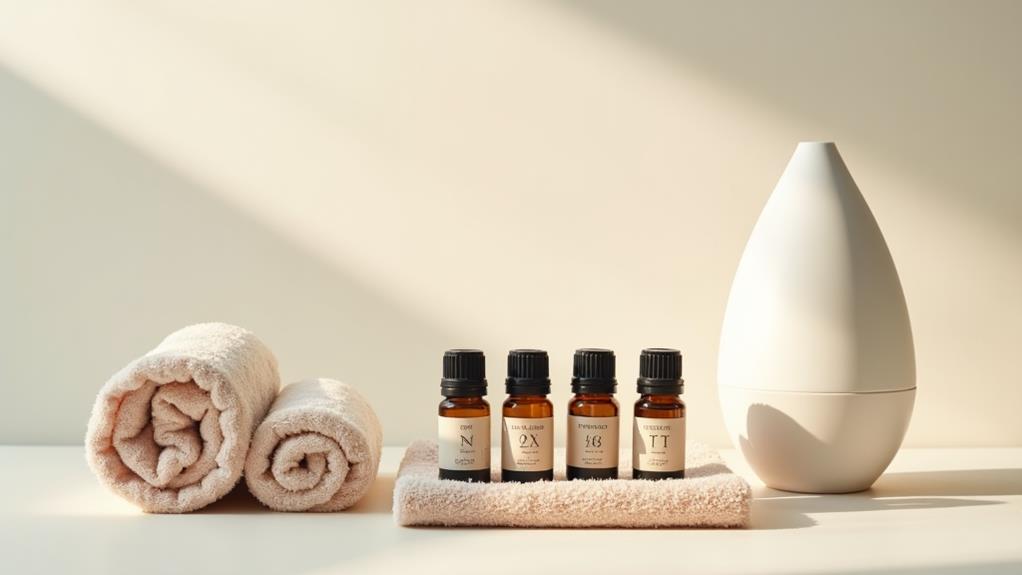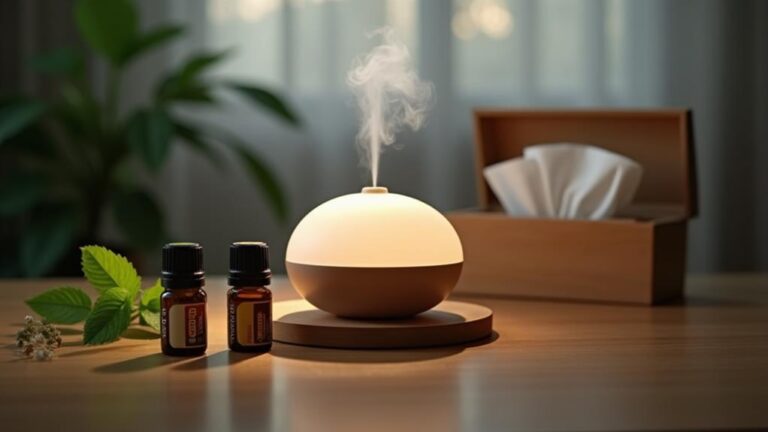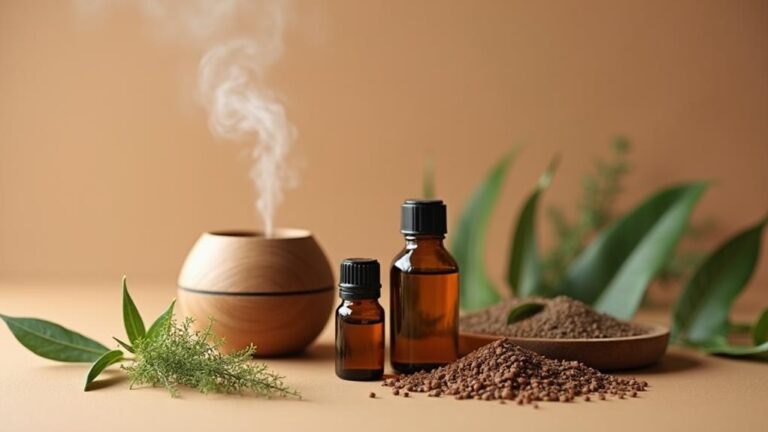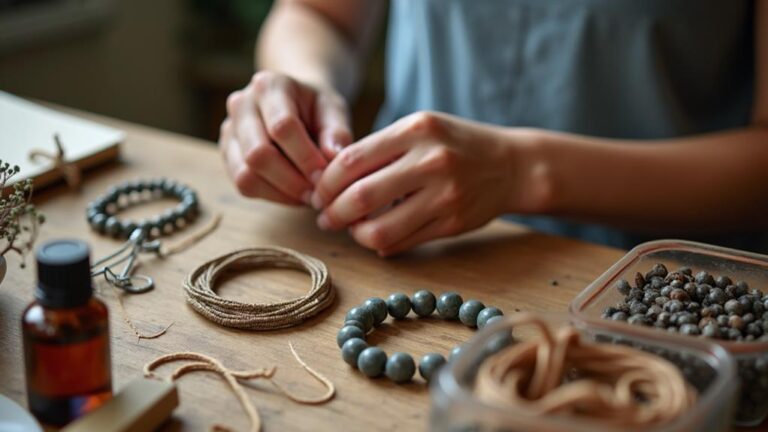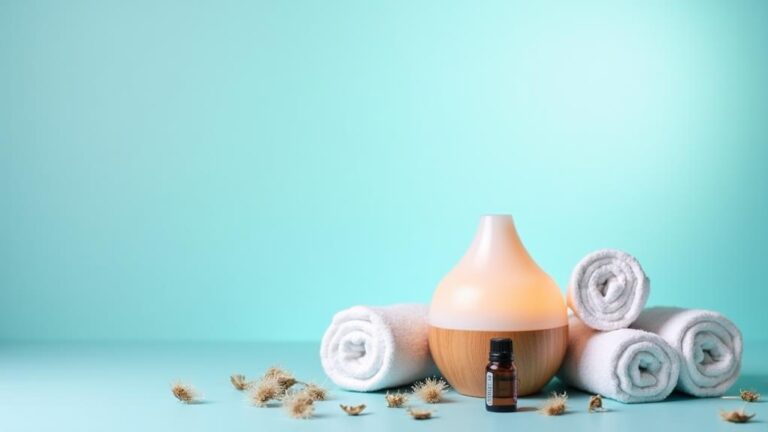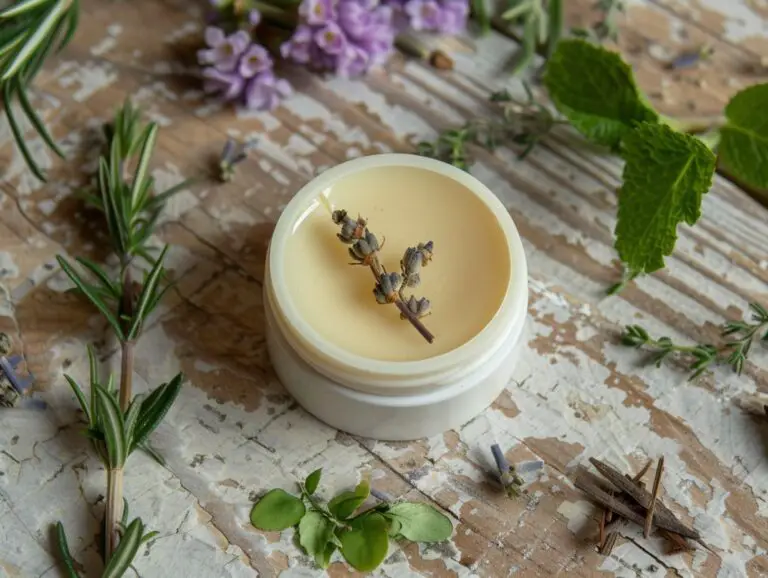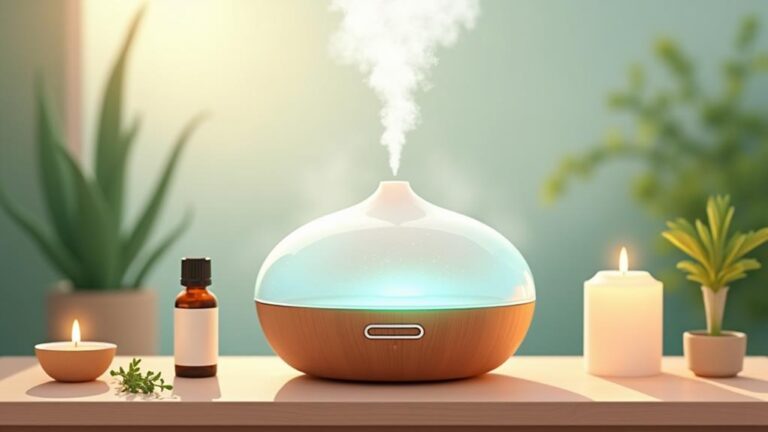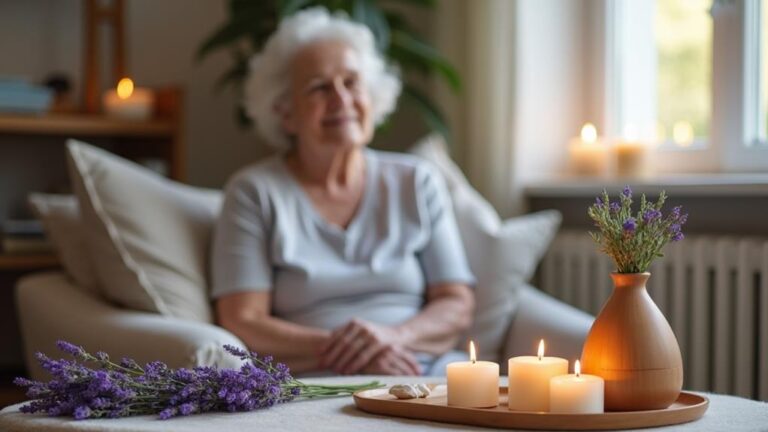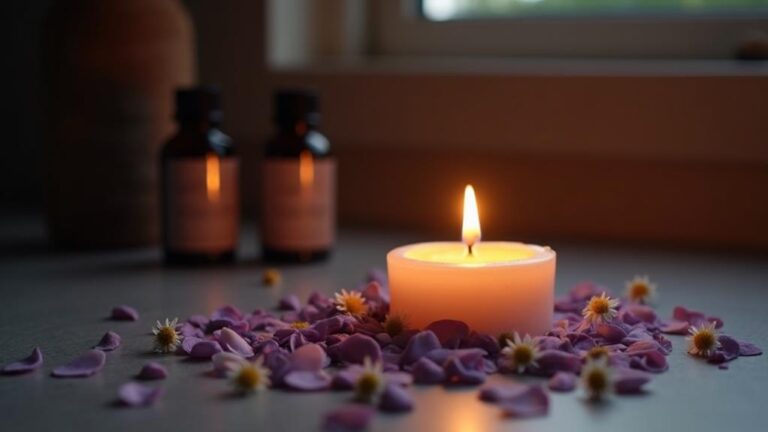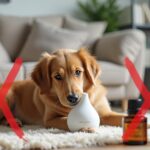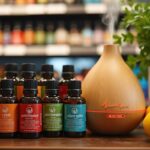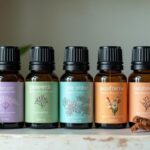You're ready to set out on a journey of self-care and relaxation through aromatherapy, but where do you start? As a beginner, it is crucial to prioritize cruelty-free practices that align with your values. By choosing certified cruelty-free essential oils, you're not only promoting kindness to animals but also ensuring a more sustainable and eco-friendly approach. But what does this entail, and how do you navigate the world of essential oils? As you explore the world of cruelty-free aromatherapy, you'll discover the perfect blend of calm and clarity, but first, let's take the initial step together.
Key Takeaways
- Choose cruelty-free essential oils with certifications like Leaping Bunny or PETA, and prioritize transparency on testing policies and ingredient sourcing.
- Build an organized aromatherapy kit with storage solutions, labels, and categorization for easy access to essential oils, diffusers, and inhalers.
- Create custom blends using fragrance profiling, combining essential oils in specific ratios, and always dilute with a carrier oil and perform patch tests.
- Start a daily aromatherapy routine, incorporating techniques like diffusion, topical application, inhalation, massage, and meditation, to promote relaxation and well-being.
- Begin with short sessions, 5-10 minutes, to gauge sensitivity, and experiment with different oils and techniques to find preferences and track progress.
Understanding Essential Oils
As you explore the world of aromatherapy, understanding the foundation of this holistic practice: essential oils is vital.
Essential oils have been used for centuries, with ancient civilizations like the Egyptians, Greeks, and Romans utilizing them for medicinal, spiritual, and beauty purposes.
Today, essential oils are extracted from plants, flowers, roots, and trees using various methods, including steam distillation, cold pressing, and solvent extraction.
Steam distillation, the most common method, involves heating the plant material to release the oil.
Cold pressing, used for citrus fruits, involves squeezing the peel to extract the oil.
Solvent extraction uses a solvent to separate the oil from the plant material.
Each method yields a high-quality essential oil with unique properties and benefits.
Understanding how essential oils are extracted will help you appreciate the complexity and diversity of these natural wonders.
Choosing Cruelty-Free Brands
Many popular essential oil brands prioritize profits over ethics, subjecting animals to cruel testing methods. As someone who cares about animal welfare, you want to make sure you're supporting brands that share your values. When choosing a cruelty-free brand, look for labels that guarantee no animal testing. Some certifications to look for include Leaping Bunny, PETA Certified, and Choose Cruelty-Free.
Here's a breakdown of what to look for in a cruelty-free brand:
| Certification | What it Means |
|---|---|
| Leaping Bunny | No animal testing, including in vitro and on humans |
| PETA Certified | No animal testing, and ingredients are free from animal-derived products |
| Choose Cruelty-Free | No animal testing, and vegan ingredients |
Beyond certifications, look for brands that prioritize transparency. Check their website for clear information on their testing policies, ingredient sourcing, and manufacturing processes. You can also reach out to their customer service team to ask about their stance on animal testing. By doing your research, you can feel confident that your aromatherapy practices align with your values of compassion and kindness.
Building Your Aromatherapy Kit
What does your ideal aromatherapy kit look like? Perhaps it's a neat and tidy collection of essential oils, carefully organized in a compact storage case.
Or maybe it's a sprawling assortment of aromatherapy goodies, spread out across a dedicated shelf. Whatever your vision, building your kit is an exciting milestone in your aromatherapy journey.
When it comes to kit organization, storage solutions are key. You'll want to choose a system that keeps your oils and accessories within easy reach, while also protecting them from light and heat.
Consider a wooden or bamboo storage box with individual compartments, or a set of stackable drawers with removable trays. Aromatherapy bags and pouches are also great options, especially if you plan to take your kit on-the-go.
As you start building your kit, think about the types of products you want to include. Will you focus on essential oils, or also incorporate other aromatherapy tools like diffusers and inhalers?
How will you label and categorize your items to guarantee easy access? By giving some thought to kit organization and storage solutions, you'll be well on your way to creating a peaceful and functional aromatherapy space that nourishes both body and mind.
Creating Custom Blends
While exploring the world of aromatherapy, you'll inevitably want to experiment with creating custom blends that cater to your unique needs and preferences. This is where blending techniques come into play. By combining essential oils in specific ratios, you can create unique fragrances that evoke emotions, promote relaxation, or even boost energy. Fragrance profiling is a vital aspect of creating custom blends, as it involves identifying the top, middle, and base notes of an oil to guarantee harmony and balance.
| Component | Description |
|---|---|
| Top Notes | Light, invigorating scents that evaporate quickly (e.g., citrus, mint) |
| Middle Notes | Rich, floral scents that emerge after top notes fade (e.g., lavender, geranium) |
| Base Notes | Deep, rich scents that linger longest (e.g., sandalwood, vanilla) |
| Carrier Oils | Used to dilute essential oils, enhancing skin absorption and shelf life (e.g., coconut, jojoba) |
When creating custom blends, start by selecting a few essential oils that resonate with your goals. Then, experiment with different ratios, taking note of how each oil interacts with the others. Remember to always dilute your blends with a carrier oil and perform patch tests to guarantee skin safety. With practice and patience, you'll develop your own unique fragrance profiles and reveal the full potential of aromatherapy.
Aromatherapy for Mind and Body
As you explore the benefits of aromatherapy, you'll discover how it can calm your mind and soothe your body.
You'll learn how to harness the power of essential oils to quiet mental chatter and ease physical tension, promoting a sense of balance and harmony.
Calming Mental Clarity
Your mind-body connection is a delicate balance, and aromatherapy can be a powerful tool to calm your mental chatter and clarify your thoughts. When you're feeling overwhelmed, it's easy to get caught up in a whirlwind of anxious thoughts and emotions. Aromatherapy can help you calm your mind and find mental clarity by promoting relaxation and reducing stress.
Incorporating calming essential oils like lavender, chamomile, and bergamot into your daily routine can help you quiet your mind and focus on what's important.
You can use these oils in meditation techniques, such as deep breathing exercises or guided meditation, to calm your mental chatter and tap into your inner wisdom. Focus exercises, like mindfulness meditation or yoga, can also help you cultivate mental clarity and focus.
Soothing Body Tension
By harnessing the therapeutic power of essential oils, you can release physical tension and promote a sense of deep relaxation throughout your body. As you incorporate aromatherapy into your daily routine, you'll find that muscle relaxation techniques become more effective, and morning stretching routines feel more rejuvenating.
To soothe body tension, try using calming essential oils like lavender, bergamot, or ylang-ylang in a warm bath or massage oil. These oils work to calm the nervous system, reducing inflammation and promoting relaxation.
You can also add a few drops of peppermint or eucalyptus oil to your morning shower to help increase circulation and ease muscle stiffness.
As you practice aromatherapy, remember to listen to your body and respond to its needs. Take a few moments each day to breathe deeply, focusing on the sensation of the essential oils working their magic.
With regular practice, you'll find that your body becomes more flexible, your mind clearer, and your overall sense of well-being more balanced.
Starting Your Self-Care Routine
Regularly taking time for yourself can have a profound impact on both your physical and mental well-being.
By incorporating self-love practices into your daily routine, you'll begin to notice a shift towards a more balanced and harmonious you.
To start, consider implementing a morning routine that sets a positive tone for the day ahead. This can be as simple as:
- Mindful breathing: Take 5-10 minutes to focus on your breath, letting go of any tension or stress.
- Gratitude practice: Write down three things you're grateful for, no matter how small they may seem.
- Hydration: Drink a full glass of water to rehydrate after a night of sleep.
- Nature connection: Spend a few minutes gazing out the window or taking a short walk outside to connect with the natural world.
Frequently Asked Questions
Can I Use Aromatherapy if I Have Sensitive Skin or Allergies?
If you have sensitive skin or allergies, you'll want to approach aromatherapy with caution. Always do skin reactions patch tests and consider allergy testing before using essential oils to guarantee a safe, relaxing experience.
How Do I Store My Essential Oils to Preserve Their Quality?
Imagine a dimly lit pantry where you store your essential oils, protected from harsh light. You'll preserve their quality by storing them in dark glass bottles, in cool environments, like a cupboard away from direct sunlight or heat sources.
Are There Any Age Restrictions for Using Aromatherapy?
When using aromatherapy, you'll want to take into account age restrictions, especially for kids; typically, it's recommended to get a child's consent around age 7, and for pets, consult with a veterinarian before starting pet aromatherapy.
Can I Ingest Essential Oils or Use Them in Cooking?
You're wise to ask: while essential oils can be tempting to ingest or use in cooking, it's generally not recommended due to internal use risks and oil potency, which can cause harm if not used properly and in moderation.
Can I Use Aromatherapy if I'm Pregnant or Breastfeeding?
As you navigate pregnancy or breastfeeding, it's essential you're cautious with aromatherapy, as certain oils can pose Fetal Development Risks. Fortunately, you can still enjoy calming benefits with Pregnancy Safe Alternatives, like gentle massages and soothing baths, ensuring a holistic approach to your well-being.
Conclusion
As you immerse into the world of cruelty-free aromatherapy, remember to take it one step at a time and not bite off more than you can chew. Start small, be consistent, and trust the process. With time and patience, you'll be well on your way to harnessing the power of essential oils to calm your mind and soothe your body. Before you know it, you'll be glowing from the inside out – and that's the ultimate goal of aromatherapy!


